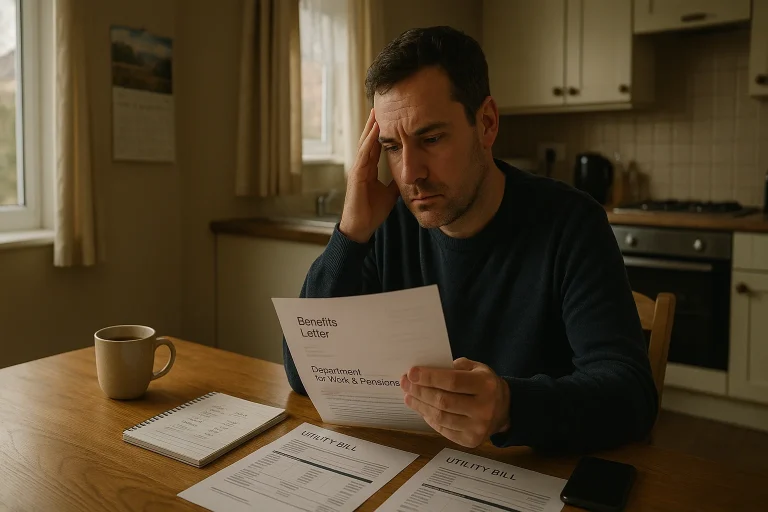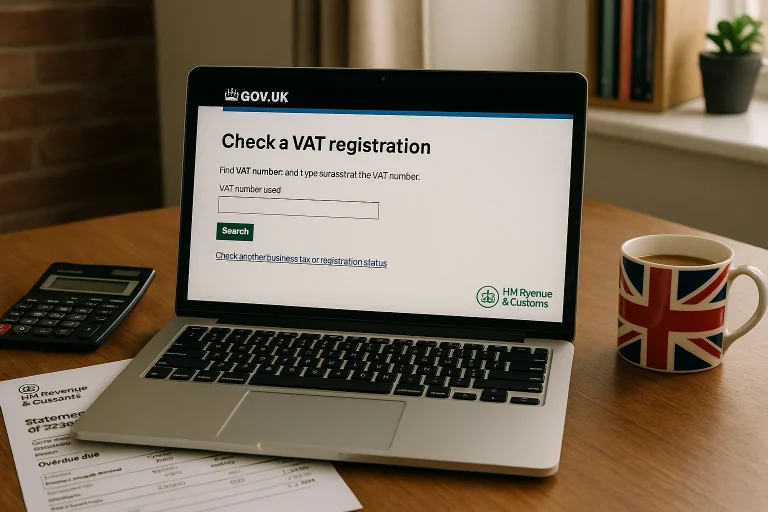Have you ever wondered if your business still needs to be VAT registered? If your annual taxable turnover is dipping below a certain level, the answer might be no.
The VAT deregistration threshold in the UK offers a clear line for small businesses to decide whether they can or must cancel their VAT registration. As of 1 April 2024, this threshold was raised to support smaller enterprises facing administrative burdens.
Understanding when and how to deregister from VAT can help you avoid unnecessary paperwork, prevent penalties, and potentially simplify your operations.
Whether you’re voluntarily considering deregistration or you’re required to do so because of changing circumstances, it’s crucial to know the rules, process, and consequences involved.
This guide breaks down everything you need to know about the current VAT deregistration threshold and what it means for your UK business.
What Is the VAT Deregistration Threshold in the UK?

The VAT deregistration threshold in the UK determines when a business can apply to cancel its VAT registration. From 1 April 2024, HMRC raised this threshold from £83,000 to £88,000, reflecting changes aimed at easing the compliance burden on smaller businesses.
This means if your taxable turnover over the past 12 months has fallen below £88,000, or you reasonably expect it to fall below that in the next year, you can apply to deregister.
The registration threshold was also increased from £85,000 to £90,000, creating a £2,000 buffer between when you must register and when you can cancel. This buffer was introduced to avoid businesses repeatedly registering and deregistering due to minor turnover fluctuations.
Key details of the threshold:
- Registration threshold: £90,000
- Deregistration threshold: £88,000
- Effective date: 1 April 2024
- Eligibility for deregistration: Past turnover below £88,000 or expected to be in the coming 12 months
The deregistration threshold applies to taxable supplies, meaning businesses dealing primarily in exempt goods or services may need further evaluation. Importantly, this threshold only applies to UK-based businesses. For Northern Ireland, similar adjustments apply for acquisitions from the EU.
Understanding this threshold is vital as it impacts your VAT responsibilities and future reporting obligations. Staying informed ensures you can act timely, avoid penalties, and maintain financial efficiency.
Who Can Deregister for VAT and When Is It Mandatory?
If your turnover is now under the £88,000 threshold, you may be wondering if you qualify for VAT deregistration or if it’s required. Let’s break down when it’s a choice and when it’s a must.
Voluntary vs Compulsory Deregistration
You can voluntarily deregister from VAT if your VAT-taxable turnover drops below £88,000 over the last 12 months or is expected to be under that amount in the next 12 months. Many businesses do this to reduce administrative tasks and avoid charging VAT to customers.
On the other hand, compulsory deregistration is required if:
- You stop trading
- You cease making taxable supplies
- You join a VAT group
- Your business is sold and no longer trading in the same form
If any of these apply, HMRC expects you to cancel your VAT registration within 30 days, or you could face penalties.
Eligibility Criteria for UK Businesses
To deregister, your business must meet the following:
- Be established in the UK
- Have a taxable turnover below £88,000
- Not expect turnover to rise above this in the next 12 months
- Not be part of a VAT group unless specific adjustments are made
Deregistration is not available if your business is outside the UK but supplies goods or services to the UK. Also, if your business only makes zero-rated supplies, you may apply for an exemption from registration instead of deregistering.
Circumstances Where Deregistration Is Required
Compulsory deregistration occurs under specific changes in business operations:
- Ceasing trading permanently or making the company dormant
- Stopping the sale of VAT-taxable goods or services
- Transferring business ownership or changing the legal structure (e.g., from sole trader to limited company)
- Joining a VAT group, requiring individual VAT cancellation
In all cases, you must inform HMRC promptly. If you fail to cancel your VAT registration within the allowed window, penalties can be applied based on the amount of VAT that should have been collected.
Deregistering for VAT can be a strategic choice or a legal requirement. Either way, understanding the timing and rules ensures your business stays compliant and avoids unnecessary VAT liabilities.
How Does VAT Deregistration Work with HMRC?

If you’re ready to cancel your VAT registration, HMRC has provided a clear process. Whether you’re doing it voluntarily or it’s mandatory, knowing how to handle it helps avoid delays and errors.
Online Method via Government Gateway
The fastest way to deregister is through your HMRC VAT online account.
Here’s how to do it:
- Log in using your Government Gateway ID and password
- Choose the “Cancel VAT Registration” option
- You will need to provide your VAT registration number, business name and address, the date you stopped trading or expect your turnover to stay below the threshold, and the reason for deregistration.
This method is ideal for businesses that:
- Have stopped trading
- Have dropped below the £88,000 threshold
- Are not part of a VAT group
Once submitted, HMRC will respond through your online account.
Postal Method with VAT7 Form
You must use the VAT7 form if:
- You’ve changed your business structure and need a new VAT number
- You’ve sold your business
- Your business was liquidated
- You are part of a VAT group that is being disbanded
To use this method:
- Complete the VAT7 form online (cannot be saved halfway)
- Print the completed version
- Post it to the HMRC address shown on the form
Confirmation will be sent by post if you use this method.
Required Information & Authorised Signatories
Whether you apply online or by post, you’ll need:
- VAT number and business details
- The effective cancellation date
- The reason for deregistration
- Your contact information
Only the business owner, company director, partner, or a registered agent authorised by HMRC can submit the application. Once your application is approved, HMRC will confirm your deregistration date and outline any next steps. Typically, this process takes around three weeks.
What Happens After You Cancel Your VAT Registration?
Once HMRC confirms your deregistration, several actions must follow to ensure your business stays compliant. The cancellation takes effect either from the date you stopped being eligible or the date you requested, whichever applies.
You must:
- Stop charging VAT on invoices
- Update business documents, websites, and emails to remove your VAT number
- Submit a final VAT return covering the period up to the cancellation date
- You must account for VAT on assets and stock if you claimed input VAT when purchasing them and the total VAT due on those items exceeds £1,000.
You’ll also need to retain VAT records for at least six years even after deregistration. If you’re using the VAT Cash Accounting Scheme, you’ll have two months to file your final return instead of one. Missing these steps can lead to penalties or re-registration by HMRC if they find that deregistration was not valid.
What Are the Financial Implications of VAT Deregistration?
Cancelling your VAT registration can impact your business finances, both positively and negatively. These implications vary based on your operations, client base, and how much VAT you usually reclaim.
Here are some of the key points to consider:
- You’ll need to pay VAT on business assets or stock still held at the time of deregistration if you reclaimed VAT on their purchase and the total VAT value exceeds £1,000.
- You must adjust your pricing, especially if you’re targeting consumers who aren’t VAT-registered, as you can now lower prices by removing VAT
- You lose the ability to reclaim input VAT on future purchases after deregistration, which might increase your costs if you buy supplies regularly
- Your final VAT return must be submitted on time. It’s your last opportunity to account for output and input VAT up to the cancellation date
- Some clients or suppliers may only deal with VAT-registered businesses, which could affect relationships or credibility
These financial considerations must be weighed carefully, particularly by businesses with mixed or high-value operations.
What Are the Pros and Cons of Deregistering for VAT?

Cancelling your VAT registration can simplify your accounting, but it also comes with trade-offs. Understanding the advantages and disadvantages helps you make an informed decision.
Comparison of Benefits vs Drawbacks
| Pros | Cons |
| No VAT returns to submit | Cannot reclaim VAT on purchases |
| Reduced admin burden | May reduce credibility with clients |
| Lower prices for consumers | Pricing adjustments may confuse customers |
| Simplified bookkeeping | Some suppliers may stop working with you |
| Attracts non-VAT registered clients | Can affect business growth perception |
Factors for Small Business Decision-Making
Small businesses, especially sole traders or micro-entities, often deregister when:
- Administrative tasks become overwhelming
- Turnover dips and VAT add no real benefit
- Customers are mostly individuals who can’t reclaim VAT
However, if your business expects to grow again, or if you purchase high-VAT equipment or services, remaining VAT registered might be smarter in the long term.
Administrative Savings vs Credibility Risks
Deregistering from VAT saves time and money. No more quarterly returns, strict deadlines, or tracking input/output VAT. But in sectors like B2B services or supply chains, being VAT-registered can project a level of professionalism and financial stability.
Before cancelling, evaluate your client expectations, supplier agreements, and projected turnover. An accountant can help you analyse whether the advantages outweigh the disadvantages in your case.
How Long Does VAT Deregistration Take and What If It’s Delayed?
After you apply, HMRC usually confirms deregistration within three weeks. However, delays may happen during peak times or if the form is incomplete.
Until you receive official confirmation:
- Continue charging VAT
- Keep submitting VAT returns as required
- Monitor your VAT online account or post for updates
If you’ve waited more than 40 days, contact HMRC VAT Enquiries to follow up. Acting quickly avoids missing deadlines or continuing VAT collection without authority.
Can You Re-register for VAT Later If Needed?

Yes, re-registration is possible if your business grows or circumstances change. You can voluntarily re-register if your taxable turnover stays below £90,000 but registration is beneficial.
Here’s what you need to know:
- Use the VAT online registration system
- You will be assigned a new VAT number unless transferring under special circumstances
- You can transfer your original VAT number if you’ve changed your legal business structure or bought a business as a going concern, and both parties complete form VAT68.
Re-registering is straightforward, but you’ll need to restart regular VAT accounting and ensure all your business systems reflect your registration status. Always consult your accountant before deciding to re-register.
Conclusion
Knowing the VAT deregistration threshold and what it means for your business can help you manage your tax responsibilities more efficiently.
With the new £88,000 limit in place, many small UK businesses have the option to reduce compliance burdens and streamline their financial admin.
However, deregistering for VAT is not just a simple form submission. It affects your pricing, records, customer perception, and financial strategy.
Whether you’re cancelling voluntarily or it’s required, taking the right steps at the right time ensures you remain compliant and financially stable. Always weigh the pros and cons carefully and, where possible, seek professional advice tailored to your specific business situation.
FAQs
Can I voluntarily deregister if I’m close to the threshold?
Yes, you can apply for voluntary deregistration if your turnover is expected to stay below £88,000 in the next 12 months.
Do I need to stop trading to deregister for VAT?
No, you can still be trading and deregister voluntarily as long as your taxable turnover stays under the threshold.
What if I exceed the threshold again after deregistering?
You must re-register for VAT once your turnover goes above £90,000 or you expect it to exceed that in the next 30 days.
Is it better to voluntarily deregister or wait for compulsory?
Voluntary deregistration gives you more control and timing flexibility, while compulsory is mandatory when you’re no longer eligible.
How does deregistration affect my VAT-registered suppliers?
It may affect trade if suppliers or clients prefer working with VAT-registered businesses due to tax reclaim benefits.
Can sole traders deregister the same way as limited companies?
Yes, sole traders and companies follow the same deregistration process with HMRC through online or postal methods.
What happens to my EORI number after VAT deregistration?
HMRC will automatically cancel your EORI number when your VAT registration is cancelled, unless you inform them otherwise.







